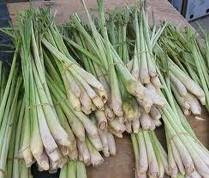LEMON GRASS
 In Ayurvedic medicine it is used to get rid of intestinal parasites, for stomach cramps and other digestive problems. It has also been used in the treatment of leprosy, bronchitis and fever. In South America it is used as a mild sedative, when drunk as a tea.
In Ayurvedic medicine it is used to get rid of intestinal parasites, for stomach cramps and other digestive problems. It has also been used in the treatment of leprosy, bronchitis and fever. In South America it is used as a mild sedative, when drunk as a tea.
 TISANE OF LEMON GRASS
TISANE OF LEMON GRASS
Ingredients
1 tsp lemon juice
sugar to taste
Method
 Pour the water into a pan and bring to the boil. Add the lemon grass and boil for 3 minutes. Remove pan from the heat. Cover and leave to stand for 15 minutes. Strain and add lemon juice and sugar to taste. (Makes two cups)
Pour the water into a pan and bring to the boil. Add the lemon grass and boil for 3 minutes. Remove pan from the heat. Cover and leave to stand for 15 minutes. Strain and add lemon juice and sugar to taste. (Makes two cups)
This is good for any stomach problems, and will soothe you if you are feeling fraught.
This has Taste and is a Treat(ment).
Lemon Grass is one of the main ingredients in a Thai curry, along with coconut milk and lots of fresh coriander. Its Latin name is Cymbopogon citratus, a relative of Cymbopogon nardus from which we get citronella, the well known ingredient of scented oil and candles which is a natural bug repellant. Lemon grass is also a bug repellant, but not as effective as its citronella relative.
It is native to southern India and Sri Lanka, Burma and Thailand. It’s a grass as its name suggests, and grows in large clumps which can grow to 5 feet tall. It’s used in perfumes, traditional medicine and cooking.
 In Ayurvedic medicine it is used to get rid of intestinal parasites, for stomach cramps and other digestive problems. It has also been used in the treatment of leprosy, bronchitis and fever. In South America it is used as a mild sedative, when drunk as a tea.
In Ayurvedic medicine it is used to get rid of intestinal parasites, for stomach cramps and other digestive problems. It has also been used in the treatment of leprosy, bronchitis and fever. In South America it is used as a mild sedative, when drunk as a tea.It is being cultivated commercially in Norfolk, UK, which is quite a surprise! Maybe it will be cheaper to buy. If you can get it fresh, the new leaves are good chopped and added to chicken or seafood dishes.
In Pakistan it is normally used dried in a tea with green tea. This has a wonderful flavour, and is very refreshing. It can be used to bring down a temperature as it induces perspiration. TISANE OF LEMON GRASS
TISANE OF LEMON GRASSIngredients
2 tbsps dried lemon grass
2½ cups water1 tsp lemon juice
sugar to taste
Method
 Pour the water into a pan and bring to the boil. Add the lemon grass and boil for 3 minutes. Remove pan from the heat. Cover and leave to stand for 15 minutes. Strain and add lemon juice and sugar to taste. (Makes two cups)
Pour the water into a pan and bring to the boil. Add the lemon grass and boil for 3 minutes. Remove pan from the heat. Cover and leave to stand for 15 minutes. Strain and add lemon juice and sugar to taste. (Makes two cups)This is good for any stomach problems, and will soothe you if you are feeling fraught.
This has Taste and is a Treat(ment).









